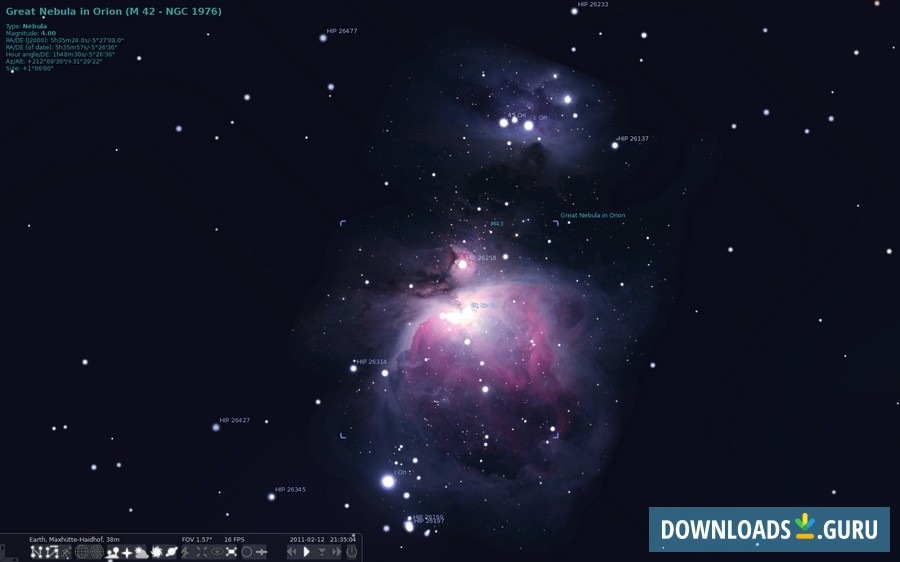
As you linger over one of the circles, the site will enlarge it and even give you a big close-up. Mapcarta has done exactly that but (sadly?) without the 80s music. what if you do not know exactly where you want to locate your story? You need someone to lay photos over the map, like VH1s old Pop-Up Video, so you can choose a location. This is where Andres heads up to barangay chapels to offer mass and hear confessions. A slice of the mountain ridge east of Bais, shown in topographic detail from Mapcarta.
Stellarium online free#
This free service uses OpenStreetMap and Wikipedia, but this is one of the clearest topographic maps I have found, especially as the topography can be laid directly over a street map.

But for authorly things I often prefer Mapcarta. I will add them here!Įveryone uses Google Maps, and so do I. Most other “historical” weather sites reach back only to the 1970s, but if you have found some that dig deeper, please contact me on social media or via email and let me know. Ī resource I have used a lot for my books in the Philippines is the Selga Chronology on typhoons.

The Isles Project uses Rowley and other historical sources on weather to put everything in one place. First there is & Martin Rowley’s “ Weather in History” which is organized by many increments, making it easily navigable. They share data sources, but are arranged a little differently. Great stuff! There is also a database.įor those outside the United States, there are some excellent sites to consider.įor those writing in the UK, climate policy and history writer Kate Zerrenner suggests the following two amazing sites. If you are in the United States or its territories (or former territories), the National Oceanic and Atmospheric Administration allows you to search historic weather data. I love forced proximity romances, by the way, so gimme. Have you ever thought to yourself, “How likely would it precipitate on such-and-such a date?” Now you can snow in your couple at a lovely cabin in Aspen over Thanksgiving, assured that this plot device is totally plausible. Honestly, it is also useful for vacation planning. The diagram above has a little of everything they offer: from clouds in the sky to precipitation, humidity, temperature, and “beach/pool score” (defined as the number of “clear, rainless days with perceived temperatures between 75☏ and 90☏”). (You can also check out the Farmer’s Almanac website here.) I have found no better weather site than -not for your immediate forecast, but for average historical data? You bet. This site only has historical data back a few years, but I find that if you generally get the right time of year and the right moon phase, it works well enough. How many beach-set books forget to talk about high tide or low tide? Yet it is the first thing you notice when you are actually on a beach because it determines how much sand you have right in front of you. However, it is best used for tidal data like the name suggests. Tides4Fishing will give you detailed information on the rising and setting of the sun, solunar activity, moon phase, and astronomical observation data. For example, if you want to take this outside to use for your night sky, choose the night view button that makes the screen red and black to help your eyes stay adjusted and avoid light pollution for gazing. I have just barely scratched the surface, and no doubt there are many other amazing features. Amazing! You can ask the program to draw constellations for you, to represent them artistically, or even to take the ground away altogether. The slider shows you how the sky changes over the course of the evening.Īnd then, wow. Then choose your date and time with the controls that pop out of the bottom right corner. Below is the location for my fictional San Honorato chapel.


You can add in an address, or even just a city, and move the pointer exactly where you want it. Meet the Stellarium online star map.įirst, choose your setting: click on the left corner rectangle that probably starts with “unknown” or maybe your current location. On my character development page, I talk about the usefulness of for moon phases, but-oh my-move over T&D because there’s a new web technology in the house, and it’s awesome, in the traditional grand scope of that word. Here are some tools for where (and when) your story might take place: For some books, though, the physical environment is a character itself, and it needs to be developed just as thoroughly-but differently. In another post, I showed you amazing free sites online that can help with character development.


 0 kommentar(er)
0 kommentar(er)
